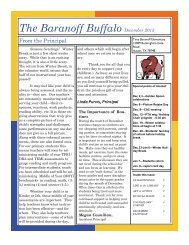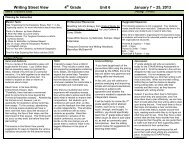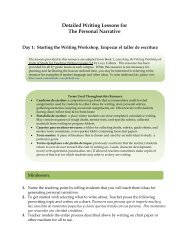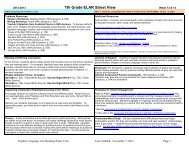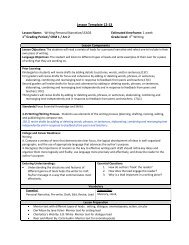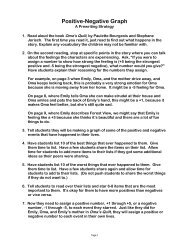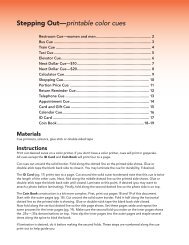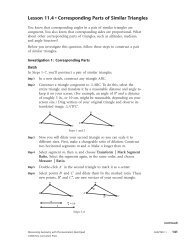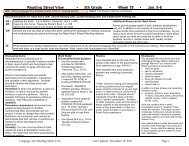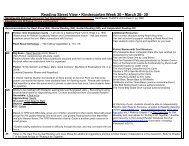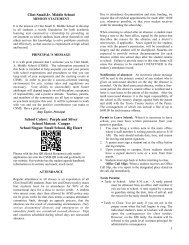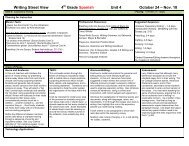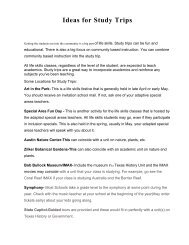Reading Instructional Planning Guide • Kindergarten – Second Grade
Reading Instructional Planning Guide • Kindergarten – Second Grade
Reading Instructional Planning Guide • Kindergarten – Second Grade
Create successful ePaper yourself
Turn your PDF publications into a flip-book with our unique Google optimized e-Paper software.
Austin Independent School District<strong>Reading</strong> & Language Arts<strong>Kindergarten</strong> (Spanish) Street ViewIn <strong>Kindergarten</strong>, the Street View Curriculum Document begins with Week 5. For Weeks 1-4,teachers are encouraged to use The First 20 Days to guide instruction.
<strong>Reading</strong> Street View Spanish <strong>Kindergarten</strong> Week 5 September 20 - 24Expository Arc 1 Focus: Reconocer la estructura del texto/Hacer Predicciones Unit 1 Focus: Mi familia y yo Unit 1Poetry Arc 1 Focus: Hacer PrediccionesRecommendations for Read Aloud (RA), Shared <strong>Reading</strong> (SR), <strong>Guide</strong>d <strong>Reading</strong> (GR), and Independent <strong>Reading</strong> (IR)RA: Fiction: Oral Vocabulary Cards – La leona y los pollitos del avestruz Unit 1, p. 30(read aloud for Robust Vocabulary lesson and Comprehension lesson - predicting) Showpictures using the cards and ask Students to tell “what they think will happen in the story.”Read Aloud Anthology - “El haz de los palitos” Unit 1, pg. 21 (story structure)Additional Resources:Make predictions with Read Aloud after title is read and duringreading of text. Confirm and contradict predictions made usingevidence from text.SR:GR:IR:In modeled reading, teacher reads a text to students, engage them by showing your thinkingalong the way.Expository/Non-Fiction:Animales Bebe Unit 1, p. 20 (comprehension lesson - make predictions)Poetry:“Andre” “Todo el mundo dice” Unit 1, p.32 (comprehension lesson used to preview andpredict)In shared reading, teacher and students all have access to the text, usually in the form of abig book. This is an excellent opportunity to model concepts of print and fluency. Studentsfollow along while teacher reads the text aloud, inviting them to join in or take over later in theweek. The book must be very predictable, the book should be enjoyable, and consider a bookthat you can use for many teaching opportunities. Read, reread, acting out the story, buildingconnections to themes and units extend the children’s knowledge.Books to be matched with Students’ appropriate level & targeted skills -- Recommend usingsmall leveled books for Approaching level, On level and Beyond level, Decodable ReadersWordless Reader: ¡A la escuela!, Abuelito AlbertoApproaching: Diversion en familiaOn Level: SoyBeyond: Familias de animals*<strong>Guide</strong>d reading selections increase in difficulty through the year, and may not match the unitfocus.Other stories with My Family and Me theme:¿Eres tu mi mama? (Are You My Mother?) by P.D. Eastman¿Tu mama una llama?(Is Your Mama a Llama?) by D. GuarinoThese books are wonderful for focus making predictions andrhythm and rhyme:Llaman a la puerta (Doorbell Rang) by Pat HutchinsEl conejito andarín (Runaway Bunny) by Margaret Wise BrownContinue to Build Independence and Stamina. Children shouldread books from bags every day.3 Maneras de Leer1. Leer las ilustraciones2. Leer las palabras3. Recontar el cuentoStudents have individual book bags or boxes. These contain books from many different sources; guided reading books, picture books, high interest books fromthe school library, read aloud books from the classroom, poetry folders, alphabet charts…….Discussing Genre:Over the course of the week you will betalking to students about expository, nonfictiontext. Nonfiction text, as defined byFountas and Pinnell is intended to providefactual information through text and visualimages. Nonfiction text focuses on aparticular topic and information is true andaccurate. The big book for the week isnonfiction and tells information aboutanimals and their babies.Phonemic Awareness/Phonics/Word Study:PA: Poems “Andre” “Todo el mundodice”Unit 1, p. 32In addition to a comprehension focusprediction, poems can be revisitedthroughout the week to reinforceconcepts about print, rhyme andrhythm. Tell students some poems useFluency:Fluency at this time of the year ismodeled with letter naming fluency,high frequency word fluency andteacher modeling fluency during readaloud time. Model what good readerssound like with intonation andexpression. Familiar poems introducedwhole group during shared readingshould be placed in poetry folders.Vocabulary:Resources:Robust Vocabulary LessonsTreasures Unit 1, pp. 10, 18, 30, 41,48Use Robust Vocabulary Lessonroutines from TE.Vocabulary: animal, imitar, juntos,parecerse, protegerOral Language Vocabulary:Build Background: Mi familia y yo
word that rhyme.See PA ActivitiesConcepts About Print: Demonstrateproper book handling, one to onecorrespondence between spoken andprinted words, cover of book, title.Phonics: Sound Spelling CardTeaching Chart 9, Word BuildingCards - /a/ a, /e/ e, /i/ i, /o/ o, /u/ uRepeat names of students that beginwith vowel sounds, locate items aroundthe room that begin with vowel sounds.Ask students to repeat sounds afteryou. Website below offer letter soundgames and activities for practice afterthe initial introduction.http://www.fcrr.org/http://www.learning.com is a websitethat is bilingual, so you have getlessons in both English and SpanishBuilding Comprehension (Expository/Non-fiction):See Recurring TEKSShared <strong>Reading</strong> Lesson Unit 1, p. 11 Animales BebePoint out that the words in many books follow a pattern. Use colored cubes,blocks, children (i.e. boy,girl,boy,girl,etc….)to demonstrate a pattern.Explain that trying to figure out what will come next in a story can help usunderstand it better. This is called predicting.Building Comprehension (Poems): See Recurring TEKSShared <strong>Reading</strong> Lesson Unit 1, p. 32 “Andre” “Todo el mundo dice”Explain that another way authors write is poetry. Some poems are written withrhyme and repetition. Preview and predict what the poem will be about based onthe title and illustrations.Suggestions for Pre-Teaching/ELPSUse Big Books and poems to model concepts about print and fluency.Pre-teach vocabulary by “planting language from the book” during previewing andpredicting what the story will be about. Use visual vocabulary resources.When working with ELL students, always use the ELPS to guide your planning. Alsouse the English/Spanish Cognates on the AISD website.Preparation for Assessment:Assessments should be appropriate for this time of year:• Anectodal notes• ObservationsHigh Frequency Word Cards:New words: unReview words: yo, soyWord Wall ActivitiesAdd words to Word Wall with children.These words are magnetic; students caneasily reach and grab words for use inwriting. Remember that the Word Wall is only forthe High Frequency Words.AISD Non-Negotiable Word ListRead the Rhyme and Chime: “Con mifamilia” Teaching chart #9Vocabulary: animal, imitar, juntos,parecerse, proteger.Brainstorm new words that describefamilies, such as: feliz, amistoso,adorar.Size WordsUnit 1, p. 25 grande, pequeño, bajo,altoStory WordsUnit 1, p. 25 cachorro, cría, oseznoPre-teach words that students willencounter all week through orallanguage, shared reading, and readaloud.Critical Questions (Expository/Non-fiction):1. ¿Por que el/la autor/a escribió este libro?2. ¿Que es este tipo de libro?3. ¿Que clase de información aprendimos de leer este libro?4. ¿Por que es importante ser un buen oyente?5. ¿Como escribió en un patrón el/la autor/a?6. ¿Puedes pensar en algún otro libro que hemos leído que tiene un patrón?Critical Questions (Poems):1. ¿Como es esta selección diferente del superlibro que leímos?2. ¿Como es igual?3. ¿Como escribió el/la autor/a en un patrón en estos poemas?4. ¿Que puedes buscar para decir de lo que se va tratar el poema?Suggestions for Interventions:Small group instruction based on student individual needs has not started yethowever, you should start informal testing so that you can start consideringgrouping your students.Anchors of Support:Create a Chart with students; add information throughout the week with students.Unit 1, p. 18 Animal Families:Familias ¿Cómo son? Nombre delde animalesanimal bebepato plumas y pico patito bebeTeacher Tips: See Daily 5 for tips on Independent <strong>Reading</strong> and self-directed learning.
<strong>Reading</strong> Street View Spanish <strong>Kindergarten</strong> Week 6 September 27 – October 1Fiction Arc 2 Focus: Reconocer la estructura del cuento/Identificar elambiente/PrediccionesExpository Arc 2 Focus: Reconocer la estructura del cuento/Usar fotografíasUnit 2 Focus: Las familias de reúnen/Families Get Together Unit 1Recommendations for Read Aloud (RA), Shared <strong>Reading</strong> (SR), <strong>Guide</strong>d <strong>Reading</strong> (GR), and Independent <strong>Reading</strong> (IR)RA: Fiction: Oral Vocabulary Cards – “El Conejo y el Coyote” Unit 1, p. 98(Read aloud for Robust Vocabulary lesson and Comprehension lesson – Predicting, Setting)Show pictures using the cards and ask Students to tell about the setting in the pictures,where might this story take place and make a prediction about what they think will happen inthe story.Read Aloud Anthology - “La vieja cama chirriante” Unit 1, pg. 25 (story structure –beginning, middle, end)In modeled reading, teacher reads to students. Engage them by showing your thinking alongthe way, stopping at the beginning, middle and end to point out story structure.SR: Fiction:Un día de Picnic Unit 1, p. 79 (comprehension lesson – Recognize Story Structure/IdentifySetting)Un día de Picnic Unit 1, p.92 (retelling cards – Respond to Literature)Non- Fiction:“Los Animales Nocturnos” Big Book of Explorations Unit 1, p.100 (comprehension lessonused to preview and predict/text features - photographs)In shared reading, teacher and students all have access to the text. Point out photographs innon – fiction text. Photographs tell the reader that the book is about real people, places, orthings. Say “I look at the photograph to see what information I can learn.”GR: Books to be matched with Students’ appropriate level & targeted skills -- Recommend usingsmall leveled books for Approaching level, On level and Beyond level, Decodable ReadersWordless: Una maleta, Fiesta en familiaApproaching: Comida en familiaOn Level: !A comer!Beyond: Una merienda*<strong>Guide</strong>d reading selections increase in difficulty through the year, and may not match the unitfocus.IR:Additional Resources:Point out story structure and setting during read aloud time.Other Fiction Stories that Focus on Setting:Ricitos de Oro y los tres Osos (Goldilocks and the Three Bears)La Casita (The Little House) by Virginia BurtonFroggy se viste (Froggy Gets Dressed) by Jonathan LondonDonde viven los monstruos (Where the Wild Things Are) byMaurice SendakContinue to Build Independence and Stamina, adding minutesto Independent reading every day. Children should read booksfrom bags every day.3 Maneras de Leer1. Leer las ilustraciones2. Leer las palabras3. Recontar el cuentoStudents have individual book bags or boxes. These contain books from many different sources; guided reading books, picture books, high interest books fromthe school library, read aloud books from the classroom, poetry folders or alphabet charts. Be sure to switch books out allowing children to “shop” for newbooks regularly otherwise children become restless with same books week after week.Discussing Genre:Over the course of the week you will bediscussing with students aboutexpository, non-fiction text. Thenonfiction text for the week “LosAnimales Nocturnos” includesphotographs that are connected toscience content. Point out that thePhonemic Awareness/Phonics/Word Study:PA: Phoneme Identity Unit 1, p. 81Phoneme Blending Unit 1, p. 103Phoneme Segmenting Unit1, p. 112Poems:Abueltio dime tu, p. 87Cinco ratoncitos p. 99 (rhyme aboutFluency:Fluency at this time of the year ismodeled with letter naming fluency,high frequency word fluency andteacher modeling fluency during readaloud time. Model what good readerssound like with intonation andexpression. Familiar poems introducedVocabulary:Resources:Oral LanguageTheme: Las familias se reúnenTeaching Chart #10 p. 78Vocabulary: actividades, cooperanTeaching Chart #10 p. 108Vocabulary: actividades, agotados
<strong>Reading</strong> Street View Spanish <strong>Kindergarten</strong> Week 7 October 4 – October 8Fiction Arc 3 Focus: Reconocer la estructura del cuento/Hacer Predicciones Unit 3 Focus: Las familias cambian/Families Change Unit 1Expository Arc 3 Focus: Reconocer la estructura del texto/Usar fotografíasRecommendations for Read Aloud (RA), Shared <strong>Reading</strong> (SR), <strong>Guide</strong>d <strong>Reading</strong> (GR), and Independent <strong>Reading</strong> (IR)RA: Fiction: Oral Vocabulary Cards – “Gallo va a la boda de Tío” Unit 1, p. 166(Read aloud for Robust Vocabulary lesson and Comprehension lesson – Identify storyelements, discuss and make predictions prompts, where might this story take place and makea prediction about what they think will happen in the story.SR:GR:Read Aloud Anthology – “Maria Manta no canta” pg. 29 (text structure)Fiction:Trade Book – La silla de Pedro Unit 1 (Fiction: story structure – making predictions)Remind Students that fiction stories did not really happen. There is an organization to thesestories with a beginning, middle and end. Sometimes a reader can use the picture, title orillustrations to predict what might happen in the story.Non- Fiction: “Diversion en familia” Big Book of Explorations Unit 1, p. 168(text features –photographs)The most important goal for shared reading is that even children with no literacy backgroundwill be able to pretend read the book after it has been read to them several times and willdevelop the confidence that goes along with that accomplishment.Books to be matched with Students’ appropriate level & targeted skills -- Recommend usingsmall leveled books for Approaching level, On level and Beyond level, Decodable ReadersWordless: Ana se muda, Ayudamos en casaApproaching: Mama, Memo y un mapaOn Level: Estoy creciendoBeyond: ¡Todos a la mesa!*<strong>Guide</strong>d reading selections increase in difficulty through the year, and may not match the unitfocus.Additional Resources:Point out story structure and setting during read aloud time.Fiction Stories that focus on making predictions:Si le das un panecillo a un alce(If You Give a Moose a Muffin)by Laura NumeroffSi le das una galletita a un raton (If you Give a Mouse a Cookie)by Laura NumeroffSi le das un panqueque a una cerdita (If You Give a Pig aPancake) by Laura NumeroffFiction Stories anchored in comprehension: Short, simpletexts keeps focus lesson concise. Model how readers use acomprehension strategy called “check for understanding.Remember to think about what the author is telling uswhen we read and to stop often to check forunderstanding.No dejes Ques la Paloma Conduzca el Autobus!(Don’t Let thePigeon Drive the Bus) Mo WilliemsNo, David by David ShannonLa silla de Pedro (Peter’s Chair) by Ezra Jack KeatsContinue to build independence and stamina duringindependent reading. Students are adding minutes toindependent reading every day, checking in during classmeeting time, asking “what is going well? What is not going sowell? How can we fix these problems so that we are ALLreading during the allotted time?IR:Introduce or revisit <strong>Reading</strong> with a Buddy: Model with a studentsitting elbow to elbow, knee to knee. Read a short book; readthe pictures first, read the words next, then retell the story with abuddy. Check for understanding, asking each other questions.Students have individual book bags or boxes. These contain books from many different sources; guided reading books, picture books, high interest books fromthe school library, read aloud books from the classroom, poetry folders or alphabet charts. Be sure to switch books out allowing children to “shop” for newbooks regularly otherwise children become restless with same books week after week.Discussing Genre (Fiction):Make connections from Read Aloudsand reading across texts (nonfiction) toteach comprehension foci, makingPhonemic Awareness/Phonics/Word Study:PA: Phonemic Identification Unit 1, p.149Fluency:Fluency at this time of the year ismodeled with letter naming fluency,high frequency word fluency andVocabulary:Resources:Oral LanguageTheme: Las familias cambian
predictions. Using this strategy helpsreaders make connections to the text,think ahead, and become moreengaged. Making Predictions is easilytaught with big books; pictures, cover,and title are easily accessible for allstudents. This strategy must beexplicitly taught. As stated by GailBoushey & Joan Moser in The CaféBook, “Predicting is a strategy mostreaders do quite well. Our youngestreaders tend to make unsubstantiatedpredictions that do not deepen theirthinking about what is happening next.Asking them to confirm predictions withthe text helps students comprehendwhat is happening further ahead.”Forming Syllables Unit 1, p. 162Phoneme Blending Unit 1, p. 171Segmenting Phonemes Unit 1 p. 180Poems:Una familia de ratoncitos TeachingChart 13, p. 148La Luna p. 155 Identify rhymeLa Luna Lunita p.167Phonics: Sound Spelling CardsTeaching Chart 13, Word BuildingCards - /a/ a,/e/ e, /i/ i,/o/ o, /u/ u, /m/ mSee Phonics TEKS to plan instruction.Building Comprehension (Fiction): See Recurring TEKS “La silla de Pedro” “MaríaManta no canta” Model thinking aloud with whole class…. “haciendo predicciones nosayuda a entender/comprender lo que leímos.”Secrets to Success: Look at the details in the selection (pictures, title, cover). Decide whatyou think will happen next based on the details and background experiences. Look backand check to make sure your prediction was accurate (confirm). Define the strategy for thewhole class, model its use in the whole group using Read Aloud suggestions above.¿Qué piensas sucederá basado en nuestra información?(ilustración, titulo,portada)¿Qué claves usaste para indicar esa predicción?¿Que tipos de claves usaste? (ilustración, palabras, o experiencia de tu vida).Building Comprehension (Expository): See Recurring TEKS“Diversion en familia” Big Book of Explorations Unit 1, p.168Preview and Predict: Look at the photographs, make predictions based on photos.They help give us information more easily than words.Text features: Photographs tell the reader that the book is about real people..Suggestions for Pre-Teaching/ELPSBefore reading to, with or next to children there should always be some kind ofintroduction. Introductions will vary with each type of reading: when makingpredictions you may not want to introduce the entire story.When working with ELL students, always use the ELPS to guide your planning. Alsouse the English/Spanish Cognates on the AISD website.teacher modeling fluency during readaloud time. Model what good readerssound like with intonation andexpression. Familiar poems introducedwhole group during shared readingshould be placed in poetry folders.High Frequency Word Cards:New words: unaReview words: un, yo, soyAdd words to Word Wall with children.It is suggested to hang the word walllow enough so that children can easilyreach and take words for use in writingusing magnetic tape behind each word.Teaching Chart #12 p. 146Vocabulary: cambiar, parientesTeaching Chart # p. G1 176Vocabulary: parientesRobust Vocabulary LessonsTreasures Unit 1, p. 154“La silla de Pedro”Use Robust Vocabulary Lessonroutines from TE.Vocabulary: cambiar, parientesTreasures Unit 1, pp. 166Oral Vocabulary Cards “Gallo va a laboda de Tío”Vocabulary: ocasión, cambiar, ansiosa,parientes, celebrarCritical Questions (Fiction):1. Pregunta a sus alumnos que comparten su parte favorita del cuento.2. ¿Fuiste sorprendido por cómo el cuento terminó? ¿Por qué si o por quéno?3. ¿Ha tenido una experiencia semejante a Pedro? ¿Cómo te sentiste?4. ¿Que claves usaste para basar sus predicciones?5. ¿Que claves usaste para confirmar sus predicciones?6. ¿Cuál fue tu ilustración favorita? ¿Por qué lo elegiste?7. ¿Pudiste decir de lo que se iba a tratar el cuento cuando vistes laportada? ¿Por qué si o por qué no? ¿Cómo te diste cuenta? ¿Qué partede la ilustración te dijo?Critical Questions (Expository):1. ¿Que característica del texto uso el autor para decirnos información?2. ¿Estuvieron sus predicciones del articulo correctos? Diga por que si o porque no.3. ¿Como supiste?4. ¿Como es tu familia diferente de las familias del cuento?Suggestions for Interventions:TPRI testing is over and grouping students based on like needs is the next step forsmall group instruction and intervention. Students who still need sentencesegmenting can be pulled for just that. A quick 10 minute segmenting lesson with3 or 4 students is a good idea. Other students in the class are reading to self.Preparation for Assessment: Assessments should be appropriate• Anecdotal notes• Observations• TPRITeacher Tips: See Daily 5 for tips on Self Directed Learning - Independent <strong>Reading</strong>, Buddy <strong>Reading</strong>.Anchors of Support:Word WallWord Winner charts with vocabulary words from the weekWord Bank of Family Words – mama, papa, tía, tío, primo/a, hermana, hermano…
Diga a los niños que esta selección esun texto expositivo o un texto de noficción. Explica o da informaciónusando palabras o fotografías. A veceses más fácil agarrar información defotografías que de palabras.Popi Teaching Chart 15, p. 225Dos ranitas p. 232El parque p.244Phonics: Sound Spelling CardsTeaching Chart 15, Word BuildingCards - /p/ p (identificar)/a/ a,/e/ e, /i/ i,/o/ o, /u/ u, /m/ m(repasar)See Phonics TEKS to plan instruction.Building Comprehension (Fiction/Fable): See Recurring TEKS“El ratoncito de la ciudad y la ratoncita del campo” Strategies for checkingcomprehension: Readers make connections to understand the characters and thestories better. When characters remind us of someone, we can think about thecharacter and the person it reminds us of to try to learn more about the character.When reading aloud or during shared reading, make connections by modelingyour thinking out loud:1. Esto me recuerda de….porque…2. Este libro es como (otro libro) porque…3. Esto me hace pensar en…Building Comprehension (Expository): See Recurring TEKS“Los amigos siguen las reglas” Big Book of Explorations Unit 1, p.245 Textfeatures: Photographs tell the reader that the book is about real people.Look at the photographs; discuss information to learn from looking at the pictures.Suggestions for Pre-Teaching/ELPSBefore reading to, with or next to children there should always be some kind ofintroduction. Introductions will vary with each type of reading: when makingpredictions you may not want to introduce the entire story. It’s okay to read onestory over several days instead of all at once.When working with ELL students, always use the ELPS to guide your planning. Alsouse the English/Spanish Cognates on the AISD website.whole group during shared readingshould be placed in poetry folders.High Frequency Word Cards:New words: esReview words: un, unaAdd words to Word Wall with children.It is suggested to hang the word walllow enough so that children can easilyreach and take words for use in writingusing magnetic tape behind each word.Robust Vocabulary LessonsTreasures Unit 2, p. 231“¿Que te gusta?”Use Robust Vocabulary Lessonroutines from TE.Vocabulary: favorita, amigoTreasures Unit 2, p. 243Oral Vocabulary Cards “Los juegos entodas partes del mundo”Vocabulary: compañero, favorito,hobby, amigo, competirReview: ocasión, cambiar, ansioso/a,parientes, celebrarCritical Questions (Fiction/Fable):1. ¿Quienes fueron los personajes?2. ¿Donde sucedió el cuento?3. ¿Este cuento te recordó de alguien o algo? ¿Por que?4. ¿Pueden ser el ratón del campo y el ratón de la ciudad amigosaunque ellos no quieren uno al otro la casa? ¿Por qué si o porqué no?Critical Questions (Expository):1. ¿Que es el tema o la ideal principal de esta selección?2. Di una regla importante que aprendiste.3. Explica por que es importante seguir las reglas.4. ¿Cual regla nos dice como tratar a otros?5. ¿Que aprendiste de las ilustraciones?Suggestions for Interventions:Tejas Lee testing is over and grouping students based on like needs is the nextstep for small group instruction and intervention. Students who still needassistance with phonological awareness, alphabetical awareness, concepts ofprint will benefit from small group instruction. Use the Tejas Lee <strong>Guide</strong> to help youfind lessons to help your students in need of extra help.Other students in the class are reading to self or with a buddy.Preparation for Assessment:• Anecdotal notes• Observations• DRA(Developmental <strong>Reading</strong> Inventory)/EDL (reading test in Spanish)Teacher Tips: See Daily 5 for tips on Self Directed Learning - Independent <strong>Reading</strong>, Buddy <strong>Reading</strong>.Anchors of Support:Word WallWord Winner charts with vocabulary words from the weekProvide another version of the fable “El ratoncito de la ciudad y la ratoncita delcampo” Build a Literature Chart to compare the two versions. Retell the mainevents.



